
views
Using Heat and Massage

Apply moist heat to the sore, stiff, or tense muscles. Adding heat to a muscle helps to dull pain, reduce inflammation, and increase blood flow to the area. While dry heat (like a heating blanket) will help, moist heat is typically more effective. Try one or more of the following: Soak a cloth in warm water, wring it out, and apply it to the sore or stiff area until it cools. Repeat as needed. Sit in a sauna or steam room for 10-15 minutes. Alternatively, take a warm shower and let the steam build up in your bathroom. Soak in a warm bath with about 8 oz (230 g) of epsom salt stirred in. This works well if large areas of your legs are sore, stiff, or tense.
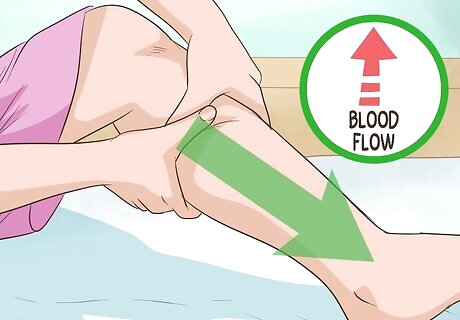
Squeeze and release your sore leg muscles for 5 minutes. Use your hand to squeeze a stiff or sore spot for 5 seconds. Squeeze firmly but not painfully, and breathe in and out slowly as you work. Move to another sore spot and repeat, and keep working over your sore legs for 5 minutes total. The pressure from squeezing the muscles will help increase blood flow to the area, which in turn will help loosen up the muscles. Squeezing can also provide some temporary pain relief. Alternatively, you can try progressive muscle relaxation, which involves tensing and releasing individual muscles throughout your body.
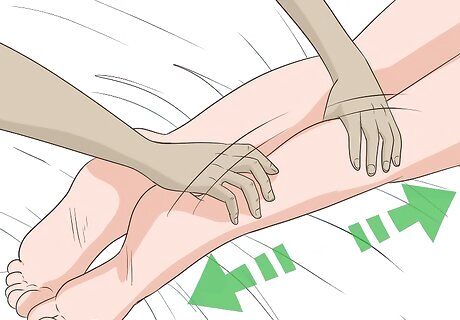
Get a leg massage from a pro or a skilled amateur. For the best results, find a licensed massage therapist and describe your leg discomfort so they can tailor the massage session for your needs. Alternatively, you can have a knowledgeable partner or friend perform a leg massage. For the massage to be effective, the person giving the massage needs to know how to apply varying amounts of pressure to different parts of your legs. Your doctor may have recommendations for licensed massage therapists in your area. Get into a comfortable position and create a relaxing environment for your massage. A good leg massage will probably take around 15 minutes, or you may want to spend 30 minutes on a full body massage.
Doing Stretches and Light Exercise
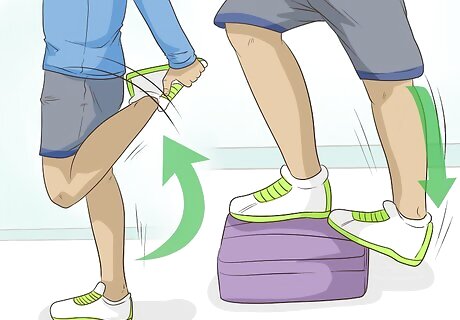
Stretch your legs before and after physical activity. Stretching your hamstrings, quads, glutes, hip flexors, and calves before exercise or physical activity will stimulate blood flow and decrease the likelihood of injury or soreness. Likewise, stretching afterward can help prevent stiffness and soreness. Try stretches such as the following: Wall hamstring stretch. This involves lying on your back with your legs extended up the wall. Heel drop stretch. For this, you'll place the toes of one foot on a step or bench, then lower the back of your foot to a horizontal position. Standing quadriceps stretch. Using a chair as support, you'll use your hand to stretch one leg at a time behind your backside. Knee to chest stretch. For this stretch, you'll lie flat on your back with your legs extended, then pull them one at a time up to your chest.
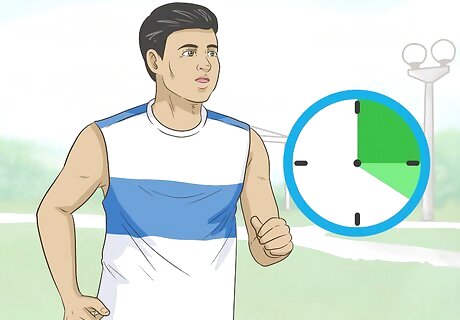
Take a walk or slow jog for 15-20 minutes if you can do so without pain. Light cardio, like walking briskly or jogging slowly, increases blood flow to your leg muscles and can ease stiffness. However, if you exercise too vigorously, you may cause added muscle tension instead. Aim to raise your heart rate slightly and keep your breathing at a rate that doesn’t prevent you from having a conversation. If you have a condition like peripheral artery disease or diabetic neuropathy that makes walking painful, you may try walking in shorter but more frequent sessions, or an alternative like swimming.
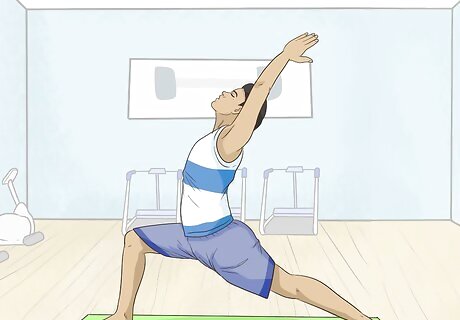
Practice gentle yoga for muscle and stress relief. Intense or high-energy yoga may make your muscle soreness or tightness worse, so stick to slow stretching poses and deep breathing. Practice various techniques yourself, or take a class at a nearby yoga studio. Try poses like: Half splits (ardha hanumanasana). Pyramid pose (parsvottanasana). High crescent lunge (utthita ashwa sanchalanasana). Extended triangle pose (utthita trikonasana).
Taking Additional Measures
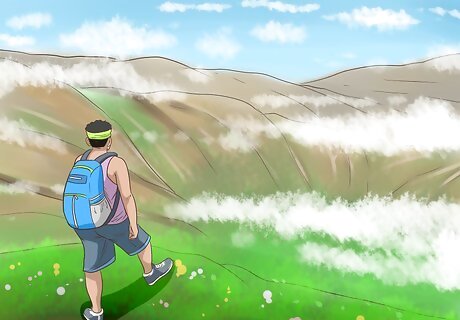
Relax your body and mind with stress reduction techniques like meditation. Many people experience tension in their neck and shoulder muscles when they’re under stress, but it can have a similar impact on your leg muscles as well. Releasing your stress in a healthy manner can help unclench and relax all the major muscle groups in your body. Try meditation or other stress-relievers like: Doing deep breathing exercises. Trying visualization techniques. Walking in nature. Listening to calming music. Talking to a close friend. Meeting with a mental health professional.
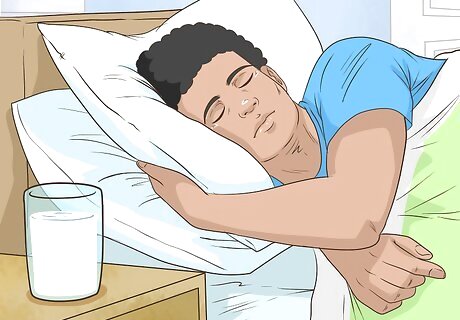
Work on getting a good night’s sleep consistently. Sleep allows every part of your body to relax, including your muscles. If you aren’t getting around 7-8 hours of high-quality sleep per night, your leg muscles won’t have adequate time to rest and recuperate, which can result in stiffness and soreness. If your leg troubles are related to restless leg syndrome (RLS), getting a good night’s sleep can be very difficult. Work with your doctor to find the best combination of treatments for your condition.
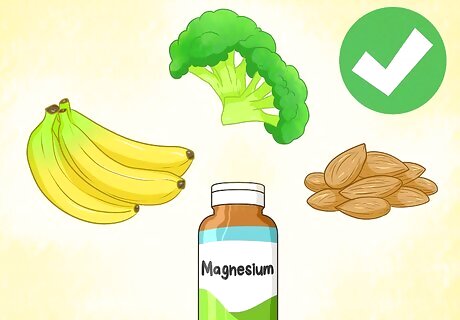
Get more zinc and magnesium in your diet, or take supplements. Zinc and especially magnesium seem to help relax muscles, although the specific ways in which this occurs are not fully known. You can up your intake of these minerals by eating certain foods, or talk to your doctor about using supplements. Nuts, whole grains, and shellfish are good sources of zinc. Spinach, bananas, and broccoli are good sources of magnesium. Although you can buy supplements over the counter, it’s best to talk to your doctor before starting any supplement regimen.
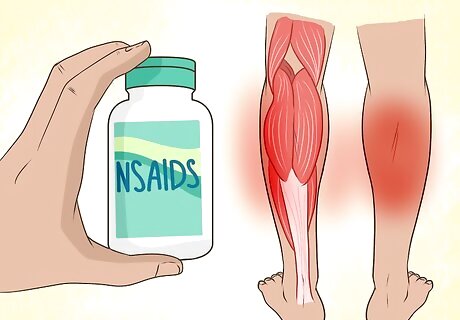
Talk to your doctor about medication options. If muscle pain in your legs is a recurring problem, your doctor may prescribe one or more medications to deal with your particular issue. If you are prescribed any medications, take them exactly as advised, and report any adverse side effects right away. Medication options may include: Over the counter or prescription NSAIDs (like ibuprofen or Advil) to relieve pain and inflammation. A muscle relaxer such as carisoprodol. Cyclobenzaprine or another medication to address muscle spasms. Diazepam (Valium) for chronic and severe pain or spasms.
Dealing with Restless Leg Syndrome
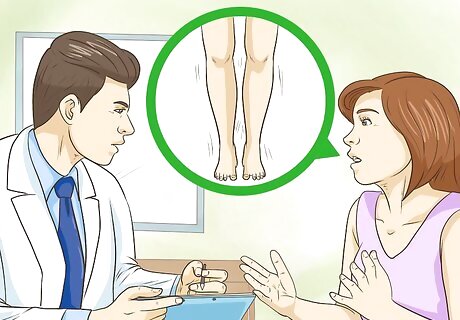
Get a medical diagnosis if you’re experiencing RLS symptoms. Restless leg syndrome (RLS) is a common condition, but can go undiagnosed because people aren’t sure how to explain their symptoms. If you experience one or more of the following, make an appointment with your doctor: A strong urge to move your legs that comes from deep within your muscles. Frequent twitching or kicking of your legs while sleeping. Symptoms that get worse at night or while at rest, and that tend to improve when you move around.

Avoid common RLS triggers, including some medications. The exact causes of RLS are still not entirely clear, but both genetic and environmental factors seem to play a role. There are several common triggers that tend to activate or aggravate RLS symptoms, including: Excess stress. Moderate to high alcohol consumption. Excessive or strenuous exercise, especially near bedtime. Smoking. Caffeine consumption—however, for some people, moderate caffeine consumption seems to help calm RLS. Numerous medication categories, including antihistamines, antidepressants, anti-psychotics, anti-nausea pills, sleeping pills, and calcium channel blockers. Never stop a medication without consulting your doctor first, though.

Maintain an active lifestyle, including daily exercise. While exercising strenuously near bedtime can aggravate RLS, staying active throughout the day seems to help ease the symptoms for many people. Aim for about 30 minutes of moderate intensity aerobic exercise (like jogging, biking, or swimming) at least 5 times per week, and 2-3 strength training sessions per week. Exercise primarily in the morning and early afternoon. Talk to your doctor before beginning an exercise program, especially if you live a sedentary lifestyle or have existing medical conditions (in addition to RLS).
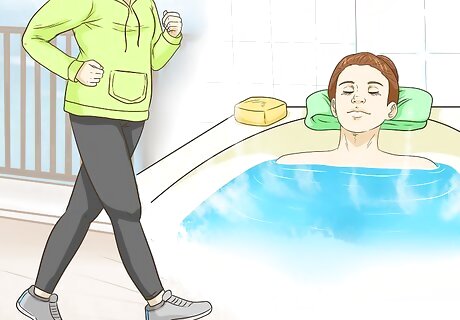
Get up and try various self-treatments when you experience symptoms. Most people experience their RLS symptoms when they’re in bed at night, and it can be tempting to stay in bed and try to wait it out. However, it’s better to get out of bed, try various methods for symptom relief, and then go back to bed. Try methods like: Getting up and walking around. Doing light stretching or yoga. Applying wrapped hot or cold packs to your legs. Soaking in a warm bath. Distracting yourself by reading a book or doing a puzzle. Putting on compression socks or pants.
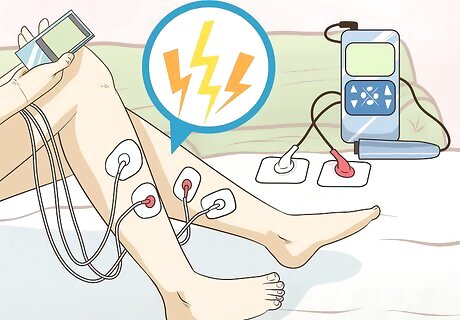
Try medications and treatments under your doctor’s guidance. Your doctor will likely recommend making lifestyle changes first. If these alone don’t help, they may move on to treatments such as: Medications commonly used for Parkinson’s disease, anti-anxiety medications, anti-seizure medications, and/or prescription painkillers. Placing a vibrating pad underneath your legs in bed. Daily, at-home TENS therapy sessions, which use low-voltage electrical nerve stimulation. Alternative therapies like acupuncture or hypnotherapy.




















Comments
0 comment